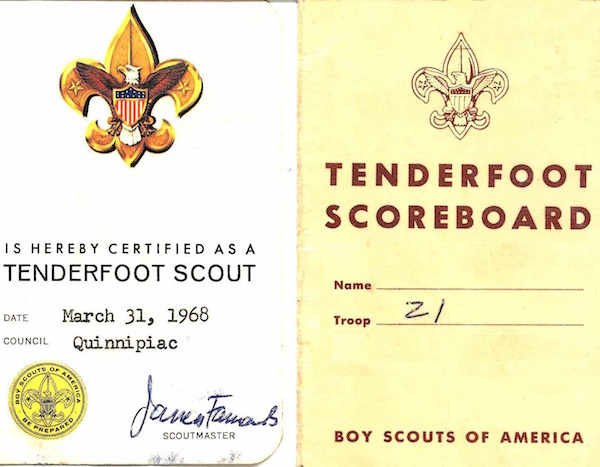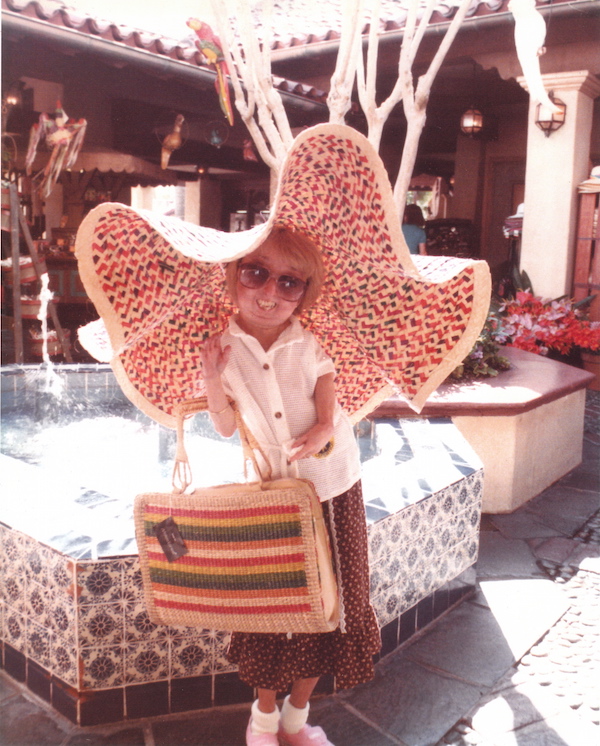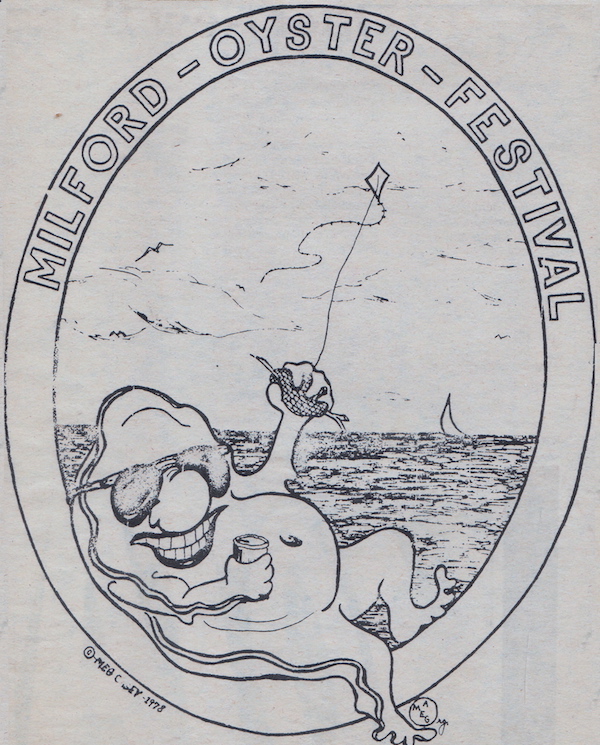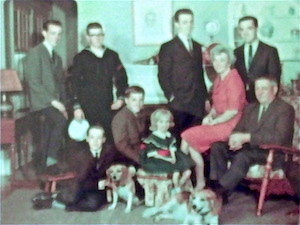


The land for Milford was purchased in the winter of 1639 on February 12 when Edmund Tapp, William Fowler, Benjamin Fenn, Zachariah Whitman and Alexander Bryan traveled to the Wepawaug from New Haven. They accomplished the purchase and concluded it with Ansantawae, sachem of the local Paugussett tribe. This was performed by an old English feudal ceremony called Twig and turf. Ansantawae took a handful of turf, stuck a twig in it, and then handed it back to the English, signifying that he was conveying the land and all that grew upon it. The purchase price was a kettle, 10 blankets, a half dozen coats, 2 dozen knives plus a dozen hatchets, hoes and small mirrors. Although by today's standards this may not seem like much, the iron implements would be highly desirable over the stone tools or cookware they were then using. 200 settlers came to Milford on foot from New Haven starting in late August followed with the landing of supplies at the head of Milford harbor over the next few months.
They moved quickly to establish the settlement with a meeting in November and authorized William Fowler to build a mill the following March which became the first water driven mill in North America.

Indian Sachem Ansantawae on Memorial Tower
photo by Daniel Ortoleva
Thomas Tibbals felt that the area at the mouth of a harbor 10 miles west from New Haven would make a good place to settle while he was fighting the Pequots in the Indian wars. One reason the Paugusset Indians in the area sold the land to the settlers was to serve as protection against other less peaceful tribes. Indian Sachem Ansantawae's family moved within the settler's fenced in palisade a few years later before settling at another encampment. 10 years after Milford's founding, hostile Indians set fire to the Burnt Plains area in 1646. Two years later, Thomas Hine rescues a Mohawk Indian earning that tribe's respect and protection for his family. In 1671, the town compensated the friendly Indians by returning the Oyster River portion of the town when misbehaving sons of the town's founding fathers burned down their unoccupied fort. In 1704 the General Court in New Haven authorized a reward for scalps of enemy Indians. The Paugasetts hunted and fished in Milford until 1831. The Philadelphia Public Ledger's travel writer Joel Cook in 1889 described Milford as having wide streets with overarching elms upon the banks of the silvery Wap-o-wang beyond the patches of salt marshes where the early settlers had crowded the Indians off of.
The settling of Milford by Puritans, less than 20 years after the Puritans founded Plymouth, was closer in time to Columbus than to America's founding fathers. This were only a century and a half after the Middle Ages compared to almost 400 years since their time. They are separate but had more in common with earlier eras.
Using these as reference points, firearms replacing weapons like the bow and arrow were new when the New World was being settled. The single-shot flintlock gun was still being developed and was not yet a refined invention. It took a long time to relaod and wasn't accurate for hunting so in battle soldiers would fire in unison. As such the early settlers were only slightly more technologically advanced than the so called "savages" inhabitating the land. Ironically, Indians adopted the superior flintlock over the older matchlock design more readily than what settlers in America purchased.
One similarity between the Puritans settling America and the Middle Ages was severe punishment or restrictions based upon their very strict interpretation of the Bible. In Milford, only church members were allowed to own land or vote. No travel was allowed on Sunday resulting with church tythingman Samuel Higby, preventing Vice President Aaron Burr from continuing through town. Their church services lasted 4 hours with the tythingman making sure no one dozed off or wasn't paying attention to the sermon. The BBC filmed a re-enactment of a 1600 era service at the First Church on April 1 1985 for episode number 7 "New Worlds" in the documentary "The Triumph Of The West". It included the founding prayer given in 1640 where Cook had commented the town "held in the true American fashion of a superior attitude after establishing a primitive church":
This "Holier than thou" attitude led to a group of settlers including Robert Treat to break away to form their own church. Treat would found other cities including the New Jersey town of "New Ark", later shortened to Newark.
The Milford High School mascot from 1952 until 1983 was an Indian wearing the war bonnet associated with western tribes which was inaccurate to the native garb of the Milford area.
In 1934 New Haven's County High Sheriff J. Edward Slavin created the First Offender Club where kids promised to not get a criminal record. His message was broadcast nationally on radio, in Courage Comics and a bus of crime fighting and punishment equipment called Jail On Wheels. He stated:
Inspired by Father Flangan's Boy's Town, He created in 1942 and opened in 1944 Boy's Village on 82 acres of farmland. It was to help provide guidance to 16 homeless and handicapped boys instead of most facilities that dominated with discipline. Charles Island was considered but the hurricane of 1938 damaged the Dominican buildings 2 days after the papers reported his plan. He passed in 1937 on acquiring land in Southbury that had been rejected by the town as the site of a proposed pro Germany youth training camp withuniformed guards.

A shortage of capable men to lead Boy Scout troops in the 1970s and 80s affected Milford, putting it in the news and history. In the early 1970s, James Farrands was known to always be chewing on an unlit cigar as the scoutmaster of Milford's Troop 21 before leading another Shelton troop around 1972. The troop went on camping adventures in a late 1950's model school bus the boys had painted blue using house paint. Farrands was a neighbor of the retired Barnum clown, Bozo Kelly, and was a descendant of one of Milford's first settlers when the colonials lived peacefully with the local Indian tribes.
There was a dark side to Farrands, off-color jokes were occasionally told to the older scouts in the integrated troop. The suggestion of going to New Haven in case there was any violence during the Black Panther trial did not interest the scouts and was not acted upon. Farrands led another troop after moving from Milford, eventually going from leading boys to commanding adults.
In 1987, he appeared on the Sally Jesse Raphael Show after becoming the first Catholic and northerner Klan Imperial Wizard on August 30 1986 at a cross burning in East Windsor, Connecticut. Farrands said the Klan allowed Catholics to join when Kennedy became President of the US, but predicted in 1990 that there will never be a black President. Facing a discrimination lawsuit requiring them to give up their name and destroy their mailing list of 11,230 sympathizers, his Invisible Empire faction disbanded in 1993 with some members forming another group under the name of the Unified Ku Klux Klan to get out of the agreement.
The Troop 21 scouts learned favorable pursuits such as outdoors skills, teamwork, self-reliance and perseverance. From observing the negative exploits, also learned to exercise better judgement. The exploits served as examples what not to do and thus most tended to not grow up as adults holding discriminatory opinions.
On a positive note, from 1971 to 1975 Catherine "Kay" Pollard unofficially led Milford's Troop 13 when no one else would take responsibility. Her being in charge was despite a ban by The Boy Scouts of America on women scoutmasters. The former Den Mother was not the first to apply to the national organization but the first to openly challenge the scouting rules. Other women avoided scrutiny by registering using their initials, similar to Star Trek writer Dorothy Fontana did as D.C. Fontana. Den Mothers led younger Cub Scouts and women were allowed with mixed older boys and girls in Explorer Posts.
A self-described tomboy, this tough motorcycle riding grandmother chopped her own wood and raised chickens but had been a music teacher. The BSA denied her in 1974 and again in 1976 prompting her to file a discrimination lawsuit. One sentiment at the time was that she would serve only as a babysitter to the young scouts. Connecticut ruled for Catherine in 1984 but the state appeals court ruled against her on July 6 1987 because the BSA is a private organization. Shortly afterwards, on February 11 1988, the BSA voted to remove the women scoutmaster restriction on their own, rather than fight appeals or challenges by other women.
After her tenacious fight of 14 years was over, the Milford Fire Department immediately sponsored a new troop so Catherine could lead it. She had been a volunteer bugler for them and this leader was further honored when a fire truck led her funeral in December 2006.


Milford Oyster Festival logo
by Meg Casey
Wearing a long blonde wig and a smile, Meg Casey maintained an independent life with a feisty sense of humor that many remember fondly. The first 10 years of the Milford Oyster Festival, from 1975 until 1984 plus a compilation design in 1985, had t-shirts designed by Meg Casey, the oldest person to die on May 26, 1985 at age 29 and 238 days, from the disease progeria where the body ages rapidly. Doctors were initially puzzled about young Meg but her dentist correctly recognized her condition. Meg born October 1 1955 grew only to an adult height of less than 4 feet , living to double of the expected life expectancy of 13. As one of the few adults with progeria she took on the challenge of becoming a role model and a vocal handicapped advocate, often using her sharp tongue to get a point across if the need arose.
Meg pushed for handicapped patients to be treated as people with dignity. Despite her objections to being viewed as an oddity during her short life, 30 years later some supernatural believers have speculated in online forums that extra-terrestrials look like Meg. She resented being considered as a lab specimen to be paraded by doctors in front of the hospital interns for observation. One of these former Yale med students used DNA testing, which was not available during her lifetime, on a tissue sample he had collected 20 years earlier from Meg. Without considering notifying the Casey family, he held a press conference in 2005 announcing that Meg may not have had progeria but a similar aging disease with the unflattering acronym of M.A.D. for the hard to remember name of Mandibuloacral Dysplasia Type A. It is common for rare diseases to be misdiagnosed due to few specialists familiar with them and the limitations of the detection methods available at the time. Meg may have subtly poked fun at the doctors when she used that same acronym for her handicapped issues column "M.A.D. (Most Able Disabled)".
No matter what afflicted her, Meg regarded her condition as an inconvenience, not defining who she was. Meg would adapt by doing things differently such as drinking from a wine glass because it was easier to hold in her toddler sized hand. Her efforts along with changing attitudes happening elsewhere in the early 1980s led Milford and other communities to start becoming accessible to all. Upon moving out when she became an adult, intensely independent Meg's house house was rebuilt with lower windows and the kitchen counters set at a height for her to reach everything. A roommate helped with some tasks she had difficulty with and help with the shopping because she didn't have a vehicle outfitted with special controls for Meg to drive.
Meg's handicapped issues column for the local Milford Citizen newspaper covered a wide range of topics from fitting in to facing death. One reader asked Meg about going dancing, 30 years before "Dancing With The Stars" included people with disabilities or others not normally considered as the type to be the belle of the ball in order to achieve higher ratings. Meg traveled to meet and encourage younger progeria patients that were not expected make it to their teens. On a moment's notice she flew to Disneyland to speak up for some progeria pre-teens after seeing on the news how the press negatively treated them as oddities while on their trip by the Sunshine Foundation. This led to an appearance on the Phil Donahue Show.

Meg Casey's family
photo courtesy of the Casey family
This sense of inclusiveness was learned early on from her family treating her equally like the rest of her brothers by encouraging her to participate in activities. Meg attended one of her brother's birthdays the weekend she passed. She was so loved by those that knew her that instead of being hidden off to the side, her family and grammar school class photos featured Meg front and center. Often photographers tended to try to emphasize how she looked different from everybody else. One photograph was titled "Growing Up Old". Meg was a pioneer of the idea of mainstreaming people facing challenges. Many people with disabilities lead normal productive lives including indoor and outdoor activities, sports and work.
With fragile bones making walking difficult and physically resembling a child with elderly features, Meg sought to be like any normal person including a wish for a boyfriend. Milford's Meg Casey won praise from President Ronald Reagan after he read "The Courage of Meg Casey" in Reader's Digest. The excerpt of this Pulitzer Prize nominated article by Nancy M. Tracy originally appeared in the Hartford Courant. The January 1984 issue of Reader's Digest also included an article about the Special Olympics.

On July 7, 2006, former Milford Democratic alderman and pension board member Una Glennon demanded at a Milford hearing that the city cut down 3 hickory trees near her Wildemere Avenue home so nuts wouldn't fall into her pool built the previous year. Neighbors noted the grandmother tried having the trees removed before her claim of being worried that her grandson with allergies would have a reaction over a nut diluted in a large pool of water. Connecticut is the nutmeg state but some nuts such as nutmegs and coconuts are nuts in name only. Although Republican mayor Ritchitelli stated this measure had department approval, Milford's tree warden subsequently resigned.
The issue of nut allergies is part of a bigger picture of reacting to worst-first thinking of expecting horrible things to happen to us for rare problems but accept other behaviors that carry more risk. Many are injured in accidents but few in the suburbs would give up driving. Cutting the trees down would deprived others from enjoying the beauty and shade offered from the trees. Shade from the sun can keep cars from getting hot. Vehicle interiors with good all around visibility from large windows are turned into a greenhouse getting above 100 degrees. A minivan or using a sun shield would not be affected as much. Although most people don't leave windows open wide enough to make a difference, solar powered window fans can promote air circulation. Heat related health issues take time and not when someone is in a warm (not hot) car for half an hour when it is 85 which is only 15 degrees above room temperature of 68 to 72.
There is a high false positive rate for skin tests which are the most common method to check for allergies. Based upon a 2015 study showing a significant increase in peanut allergies due to avoiding nuts, the New England Journal Of Medicine recommended that infants be gradually introduced to peanuts so they build up a resistance and do not develop a nut allergy from being too clean that our bodies react to normally harmless substances. Another opinion is news coverage repeatedly hyping the same rare incident all day, our minds interpret it to be a half dozen cases. Hearing symptoms lead many people to believe they may have or were exposed to a health concern. Recently a Milford girl was kept out of school after she had visited 1000 miles away from where the Ebola outbreak was.
Although hickory is related to walnuts it doesn't appear to be a common allergen. Although more cases of peanut reactions are being reported these days, the relative risk for any nut death is quite small, food allergy deaths amount to only 200 per year out of the United States population of 360 million. The CDC puts the actual figure at 11 with the higher, but still quite low figure often quoted as from a spokesman for EpiPens. This is a lower or similar rate than many other risks we face that we don't worry about. By comparison, close to 120 from falling trees and 49 by lightning are killed per year. A risk assessment author when reviewing the book "Life Without Lawyers" by Phillip K. Howard of Common Good cited this example of bad laws and in Time magazine.